Teaching Preschoolers About Wildlife Conservation
Affiliate Disclosure: “This post contains affiliate links, which means I receive a small commission, at no extra cost to you, if you make a purchase using those links.”
World Wildlife Day will be celebrated on March 3rd. The theme for this year is “Partnerships for Wildlife Conservation“, seeking to unite governments, institutions and people in general across the globe to work and cooperate united to preserve the wildlife in our planet, and I think, this is an excellent excuse to teach preschoolers about wildlife conservation.
Since young children might have a hard time understanding the concept, the better way to teach it, in my opinion, is using examples that they can experience with their senses and breaking it down in different types of activities.
This post offers you a FREE 47-pages long pack, with several activities, with beautiful pictures, which you can download it at the end of this post.
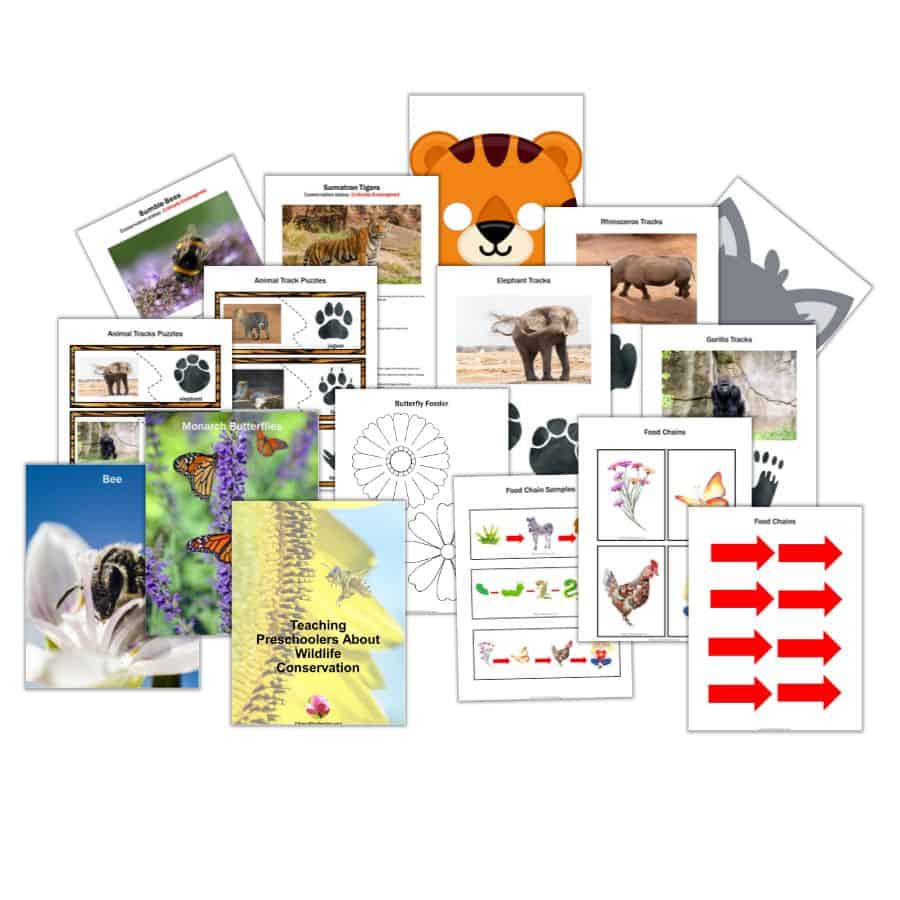
Why is Important for Children to Know about Wildlife Conservation
Our young preschoolers will grow and might experience firsthand the devastation that causes the lack of care and responsibility that humans are showing to preserve important ecosystems, and these children might make a difference in causing important changes for the best, more so when they become adults.
One way our kids can make a difference right now is learning about wildlife conservation, and then tell about it to family and friends. They can help by learning to be careful about what they use and buy, and making sure they encourage their families to do the same.
Another way they can help is by protecting the wildlife they see around them, when you teach them the important role that each of them play in a healthy ecosystem, because when one of them disappears, it affects the rest of every life that coexist there, not just in land, but in water too.
Activities to Teach About Wildlife Conservation
Explain What Wildlife and Conservation Means
First, preschoolers need to know what wildlife means. You can teach them the concept by explaining to them that wildlife means all the living animals that are not pets, including mammals, birds, bugs and aquatic life.
Then tell your preschoolers that conservation means caring for and protecting nature, wildlife and the environment, especially endangered species, to prevent them from becoming extinct.
Teach About Pollinators
Explain that pollinators are animals responsible to help plants produce oxygen, seeds, fruits and vegetables, and without them, these plants will cease to exist. About 80% of flowering plants and more than three-quarters of crop plants that produce food for humans rely on pollinators to produce their products. That is why it is essential to teach our children about the important role these pollinators play, so they protect them for life.
Now, what are pollinators? Pollinators are all the animals that keep plants alive and producing their products and oxygen, which it is what humans and animals breathe.
Pollinators visit flowers looking for food, shelter or materials to build their nests. When they do it they get pollen grains stuck on their bodies, and when they visit another flower that pollen goes into the stigma fertilizing the flower to produce a fruit or vegetable.
Another important fact is that pollinators and flowers depend on each other. They cannot survive without the other.
There are many pollinators. Among the most important ones we can mention:
- Beneficial insects such as bees, butterflies, moths, certain types of beetles, wasps, ants, mosquitos and flies.
- Birds like hummingbirds and doves.
- Mammals such as bats, lemurs, and honey possums.
- Reptiles like lizards, geckos, and skinks.
You can find real pictures of pollinators in the pack, including bee, Monarch butterflies, moth, beetle, wasp, ant, hummingbird, and lemur. I will suggest to print them in white cardstock and laminate them, for durability.
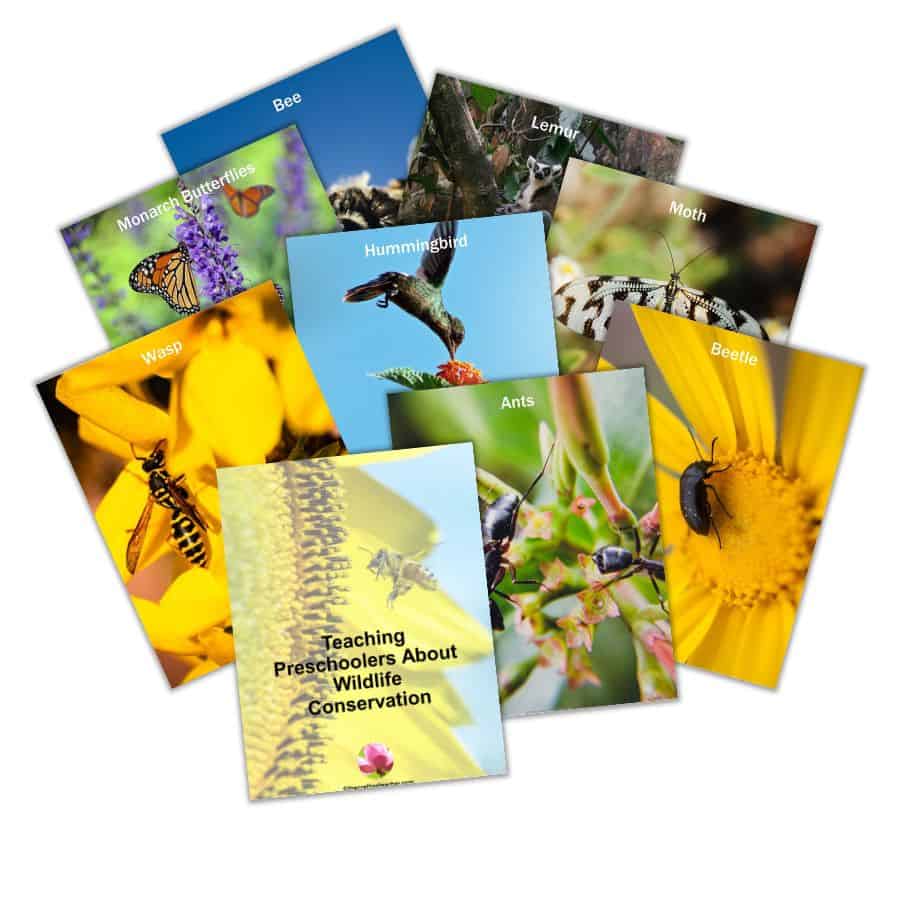
Some Activities You Can Do Are:
- Introduce the pollinator process. This video can help you explain the process to your kiddos.
You can also find very nice diagrams like the one below at the istockphoto.com website.
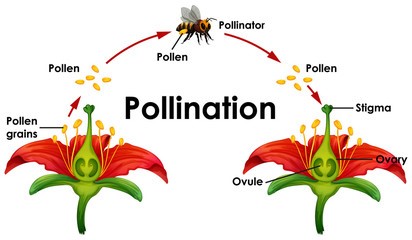
- Start a pollinator garden at home or in the community. Select an area or garden bed away from foot traffic, with good exposure to sunlight. Place good soil on it, and plant some of your area native plants that produce a lot of nectar, and bloom from spring to autumn.
- Organize a field trip to your local botanical garden, apiary, or bird sanctuary to observe the habitat and have a pollinator hunt. If that’s not possible, take them to the playground or backyard.
- Help your preschoolers make a pinecone bird feeder. You will need: pinecones, paper plates, lard or peanut butter, birdseeds, string. Give each child a paper plate with squash lard or peanut butter on it. Have children roll their pinecones in it, until is completely cover. Give them another paper plate with birdseeds on it, and have them roll their covered pinecones in the seeds, until the pinecone is cover. Tie a string on one end of the pinecone, and hang it from a tree branch.
- Invite your children to make a butterfly feeder. The best food for butterflies is flower, but you can invite your kids to make this simple craft. To do it, give each child ae flower shape printed in white cardstock. Have them color it with crayons or markers, and laminate it. Make a small cut in the center, and pass through a straw. Glue a bottle cap on top of the straw, and place a cotton ball wet with sugared water inside. Instruct them to stick the flower in the soil inside a pot or a garden bed. This pack includes two flower templates, for your convenience.
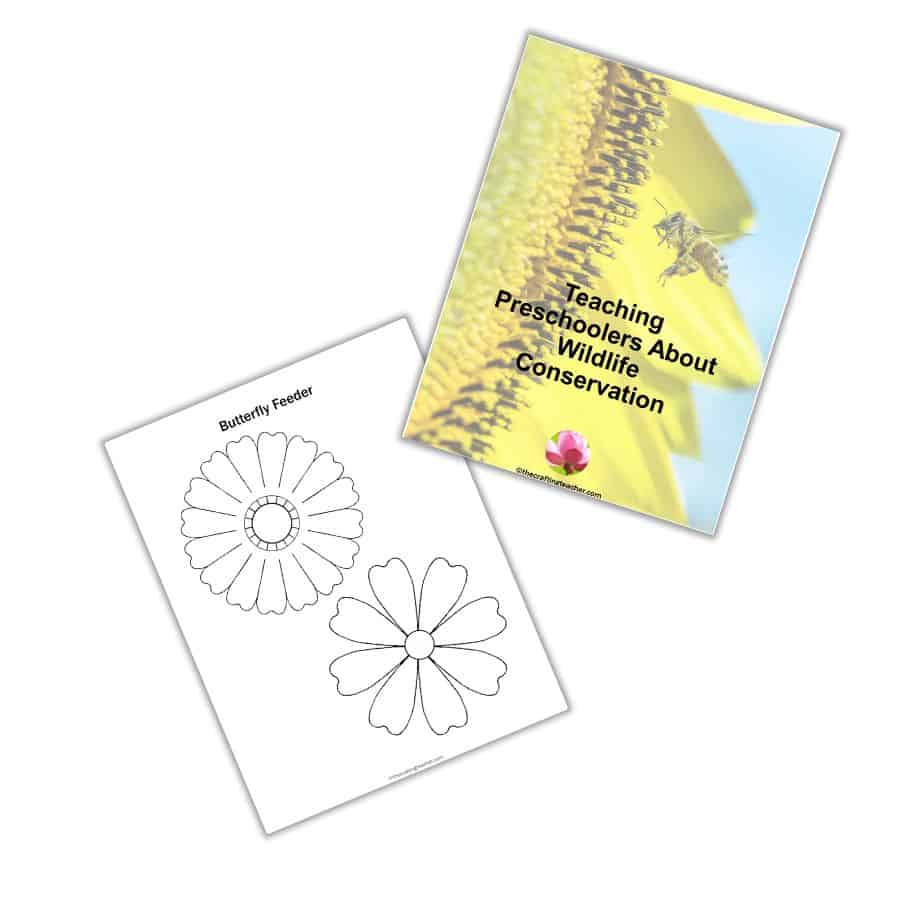
- Explain food chains. Discuss that animals and plants rely on each other to survive. For example, plants need soil, water and sun for energy. Animals need water, shelter and food to survive, and depending on the animal food could be plants or other animals. Since plants and animals have to use what their habitat offers, a food chain shows how each of them gets its food.
Explain that, when a part of a food chain become extinct, the food chain is broken, and the rest of the animals in that chain might not be able to survive.

Here is another example in picture form:

I’ve included three different types of food chains in the pack. You can use the cards provided to show examples, and have them create food chains with them. Just print them in white cardstock, cut them out, and laminate them for durability. Then let the children create their own food chains.
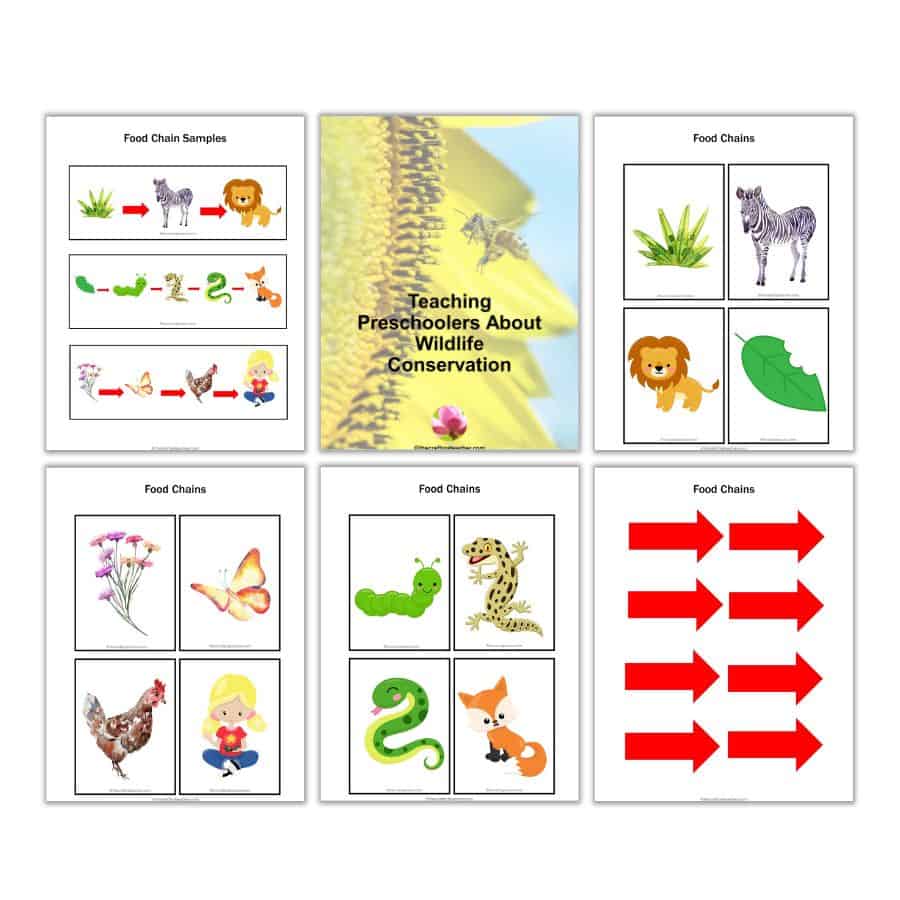
- Have them match wildlife with their tracks. Print the animal footprints posters provided on the pack in white cardstock, and laminate them for durability. Show each of them to the children, and then ask the class to talk about the footprints trying to describe the them using adjectives. Then present the tracks puzzles and invite them to match each animal with its tracks.
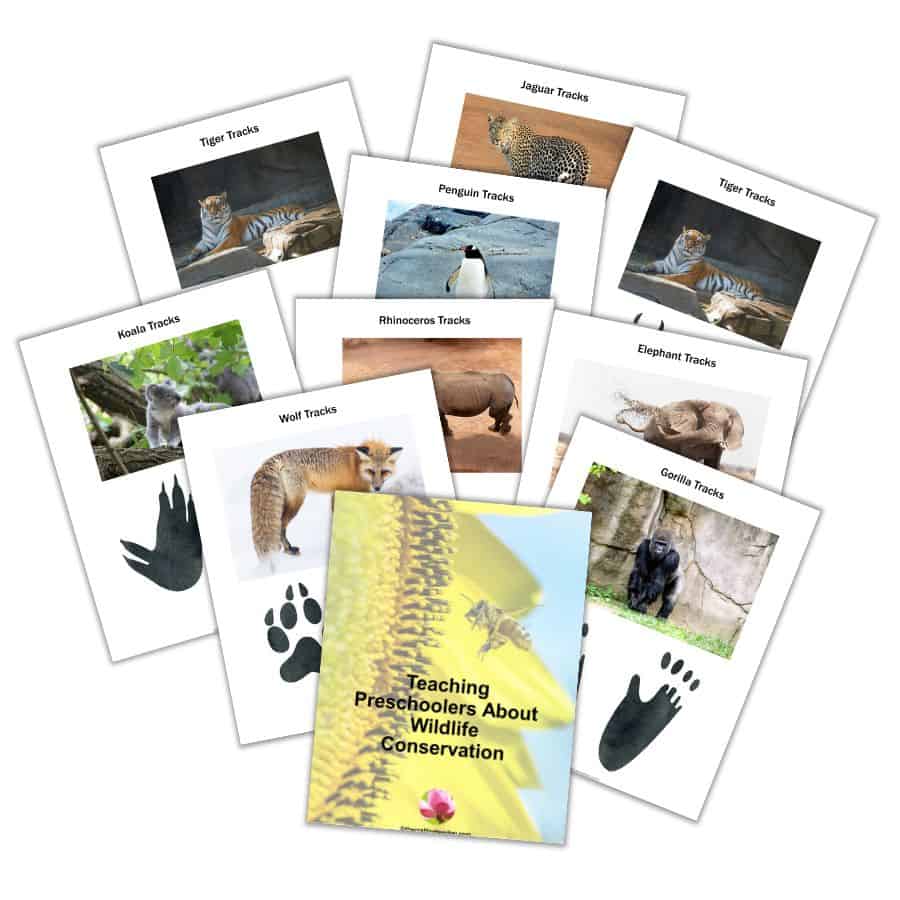
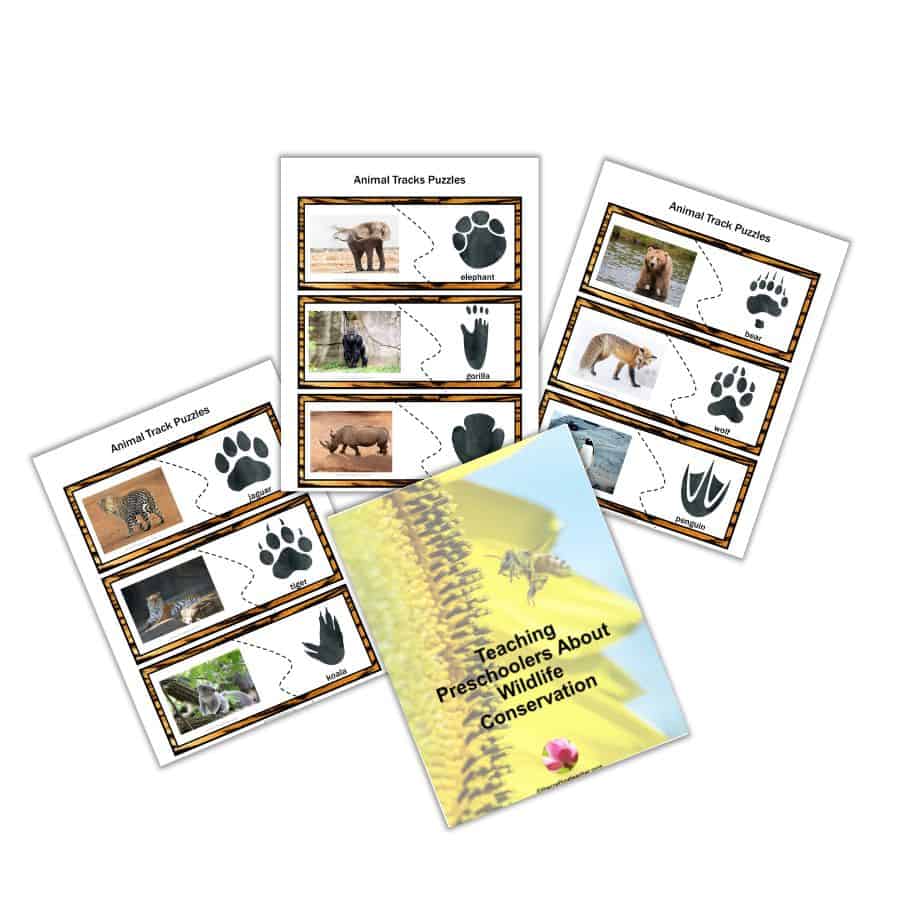
Introduce Your Children to Endangered Species.
According to the Wild Animal Foundation, scientists gathered together to investigate 150,000 different species. Out of those, 40,085 are threatened by extinction, such as rhinoceros, red pandas, penguins, lions, bees, elephants, polar bears, turtles, and so many others. This is a super worrisome situation, because every single one of these species play an essential role to keep the balance and health of their ecosystem. Because of this terrible reality, it is essential that our children know about it, to understand the importance of wildlife conservation.
The first thing you need to do is explain what means to be an endangered animal. Explain that endangered animals are at risk of no longer exist on Earth. It might help to have them think about their favorite toy. Tell them to imagine that the toy they have is the last one in the entire world. They will probably take good care of it, so they can keep it forever, but everybody, including their dog, want to play with it throwing it to the air, and against the wall. Their toy is endangered. One day a big dog or a car rip the toy to pieces. If that happen, the toy will become extinct.
Explain that when animals become extinct, it’s mostly because people have caused it by:
- Destroying their habitat by deforestation, agricultural uses, rode construction and other causes.
- Poaching them or placing traps that harm them.
- Introducing invasive species that take over the habitat.
- Transmitting human diseases for which they don’t have immunization.
This way you can help your kids understand better how these human actions cause so much harm to wildlife, and how humans also can have a positive impact by taking action in protecting the environment and the wildlife that lives in it.
Activities Ideas:
- Introduce the children to some critically endangered species, explaining the reason why they are endangered. Present the provided critically endangered animal posters printed in white cardstock, and laminated for durability. Talk to the children about some key facts about each of them. To make a point why they are critically endangered, you could also mention how many of each of animals are left in the wild, and what we can do to help.
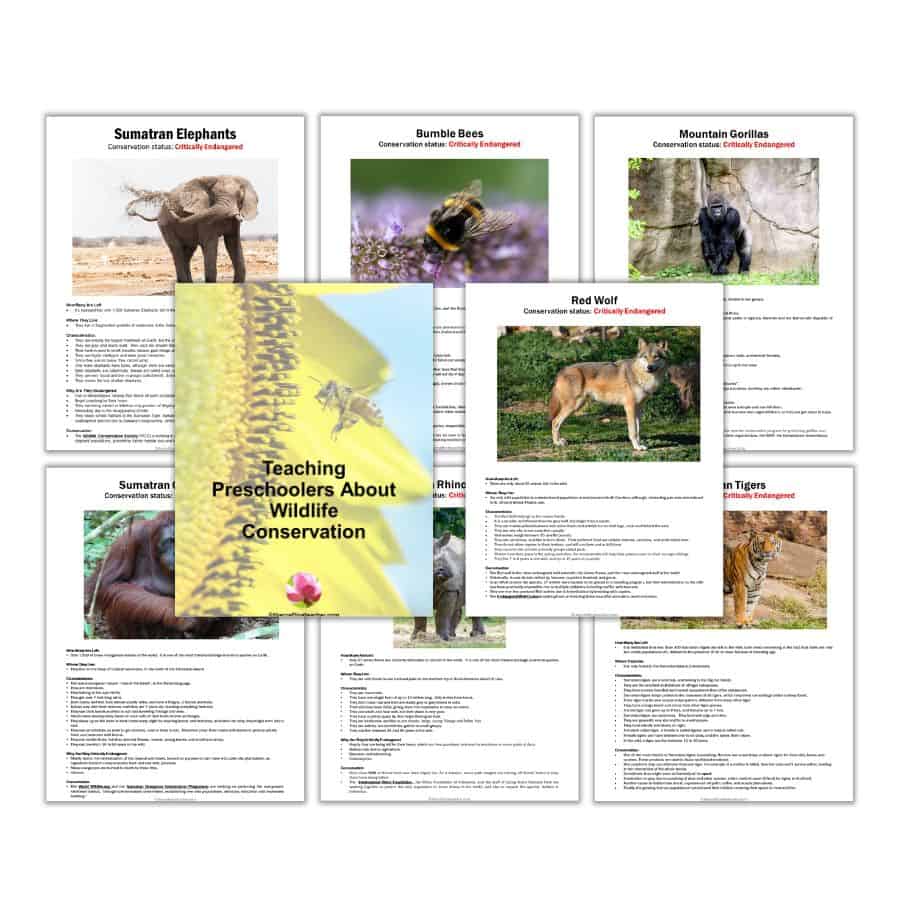
- Have them pretend to be wildlife using masks. Print out the provided masks on white cardstock and laminate them for durability. Have each child select a mask, tell what he/she knows about the animal, and put it on. Then ask children to act out how the animal on their masks moves.
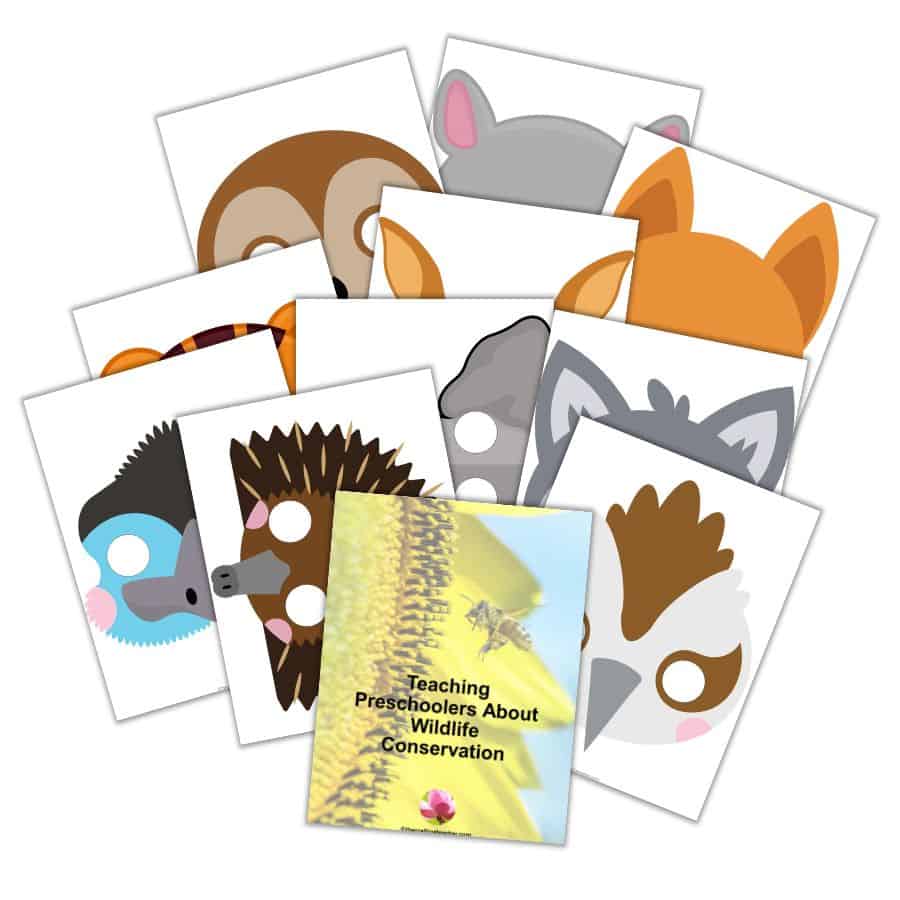
- Do an Oil Spill Experiment. Remind them how wildlife is threatened by human activities like deforestation, poaching, and pollution. Explain that many industries spill oil in the waters, causing serious damage to wildlife.
Get Parents Involved
There are a lot of activities that parents can do at home to support their children learning about wildlife conservation, and providing those with the information might even encourage them to participate in this effort, if they are not doing it already. Prepare a letter with the activities suggested below and send it home with your children, so the parents get the information.
The activities mentioned are:
- Start a bird list with your children, looking for birds in your backyard or neighborhood. Observe their behavior. Are they carrying nesting materials or insects to feed their babies? Write down their color, size, sound and shape, and try to identify the species by visiting The Cornell Lab’s All About Birds website.
- Buy or build nest houses for birds, and hang them on the trees in your backyard. You can find unfinished bird houses at JoAnn or Michaels. The children can decorate them, making it an excellent craft and fine motor activity.
- Tour your neighborhood for ducks, geese or peacocks counting. It is recommended not to feed them, not even with bread, because wildlife can get sick with human food.
- Have a wildlife survey in your backyard. Draw every animal you see, describe its color, shape, size and what its doing, and write down its name. You can use the BugGuide or iNaturalist websites to help with identification.
- Invite and protect wildlife in your backyard by providing them with food, water, and shelter. There are many projects you can do with your child listed in this Department of Energy and Environmental Protection website.
- Observe the life of wildlife such as birds, ants, frogs, spiders, wasps and squirrels. How are they moving, what are they using to make their nests, what happens when they have babies, do you see any tadpoles? Invite your child to draw what they see, and dictation about his/her descriptions, and the name of the animal.
- Research which species are endangered in your area, help your child tell other people about it and take measurements to avoid putting them at risk. Knowledge is power, and the first step to protect wildlife is awareness.
- Make sure your home isn’t a hazard to wildlife. Secure bins and reduce your water usage, so there is more water available to local wildlife.
- Find out which plants are native to your area and good to attract pollinators, and plant them in your garden. This will provide food and nesting for the wildlife in your area.
- Avoid using toxic herbicides or pesticides in your garden. There are often natural alternatives that don’t harm wildlife.
- Get involve with your child in organizations that work on wildlife conservation, either giving them donations, “adopting” an animal or actively participating as volunteers or campaign promotors. A couple of places to start are your local zoo and wildlife park.
- Find out which plants are native to your area and good to attract pollinators, and plant them in your garden. This will provide food and nesting for the wildlife in your area.
I’ve included an infographic that you can provide your parents, to keep these ideas handy.
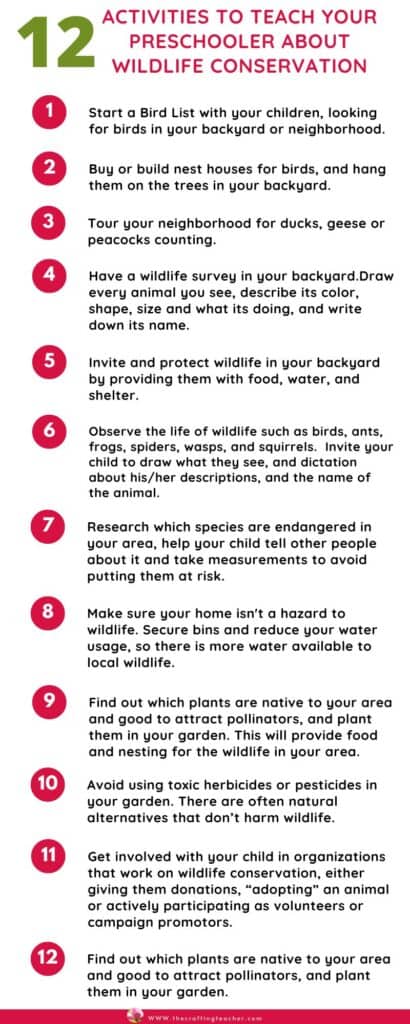
Storybooks
Reading to your children about endangered species and wildlife conservation is one of the best educational activities you can do to teach your kiddos about this, and plant in them the love and desire to help their environment and its habitants, as they get older.
There are many books that you can use, both fictional and nonfictional. You can find some at your local library and used book store. I personally love Amazon because you can get anything fast, and I love to constantly add books to my collection. These are some I like. I added my affiliate Amazon links to make it easier for you, just by clicking on the pictures.


















Pin It For Later
If you are in a rush and don’t have time to read the post and download the printable but want to save it for later, pin it to one of your Pinterest boards.
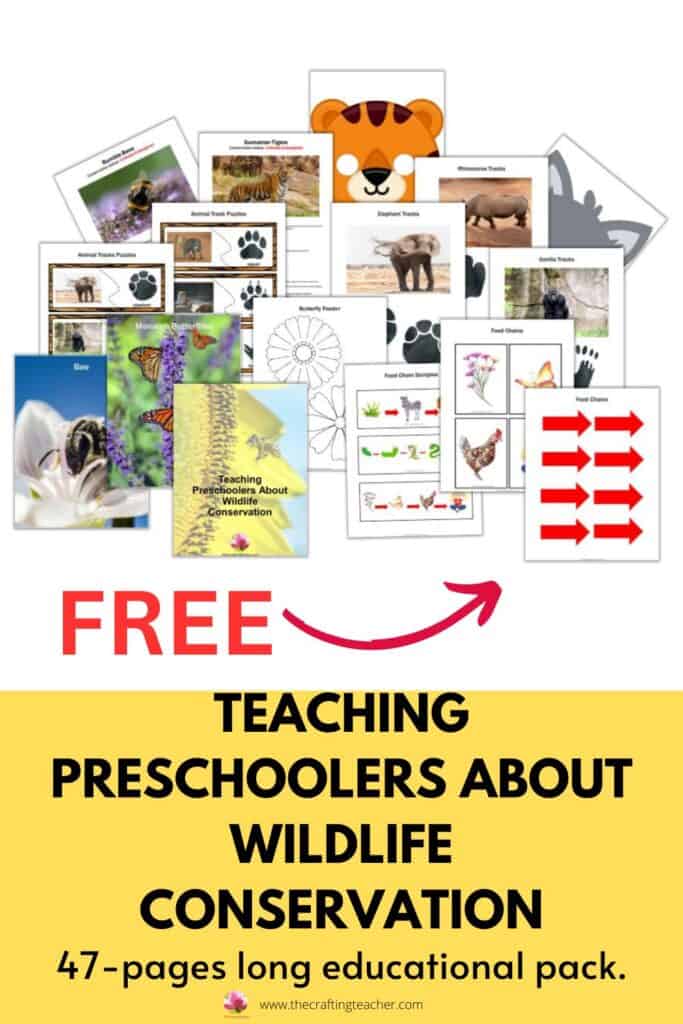
It is important that children have a better knowledge of what wildlife conservation means and you, as teachers and parents of preschoolers can encourage them to love, support and protect it. Together, we can stop the decline and extinction of so many species, so that future generations can enjoy them and we all can have balanced ecosystems where all species thrive.
I hope you enjoy these ideas, and help you have fun explaining to your kiddos about wildlife conservation and the meaning and purpose of World Wildlife Day. To get the FREE pack, you just have to click on the link below and put your information, for an immediate download.
Be happy, safe, and creative. I wish you well.
Love,

P.D. Please let me know if any of these ideas worked for you, and, if you have others, I would love to hear them as well. There’s not such thing as doing too much to save our planet and all its inhabitants.

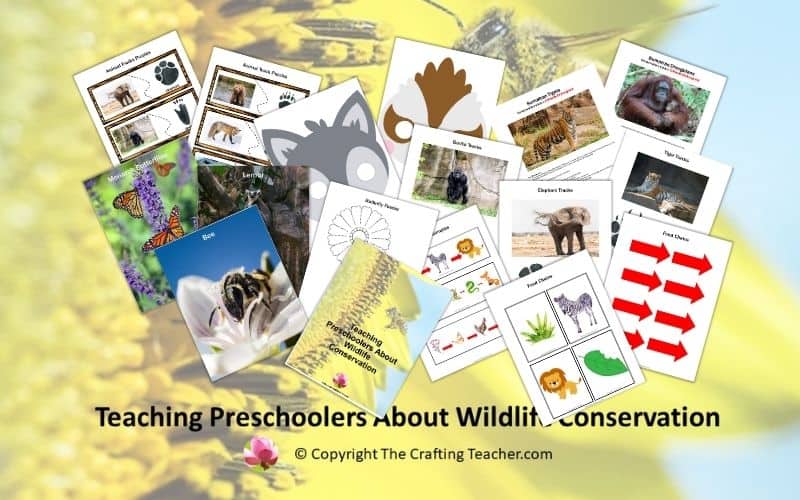
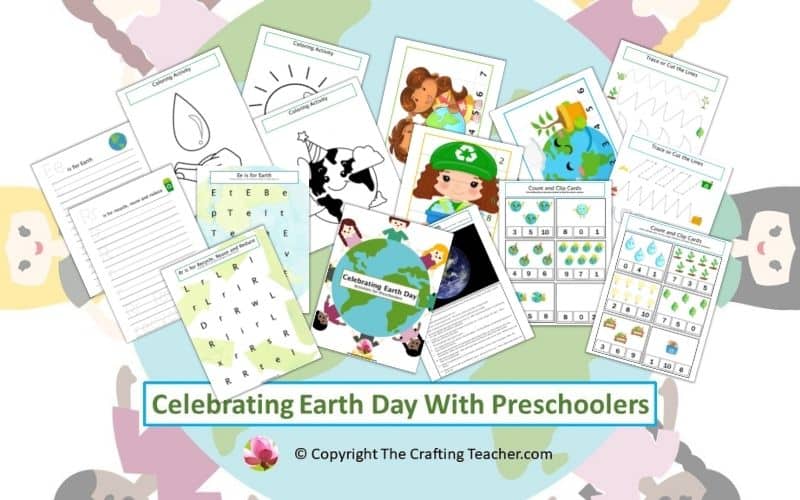
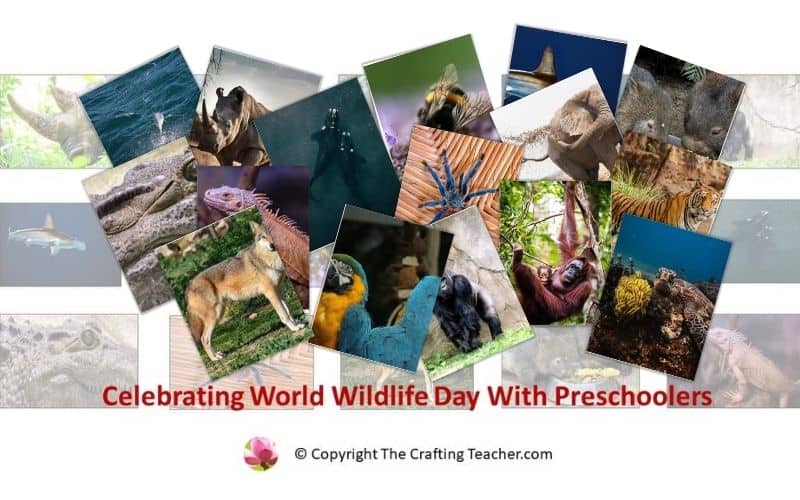
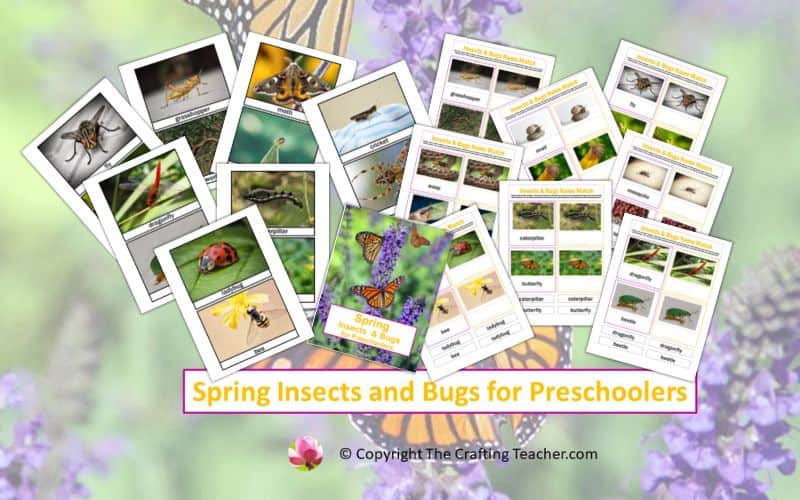
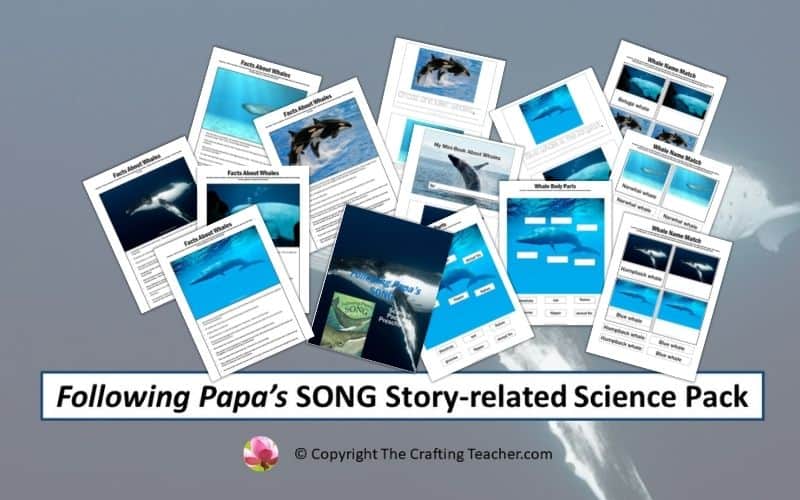
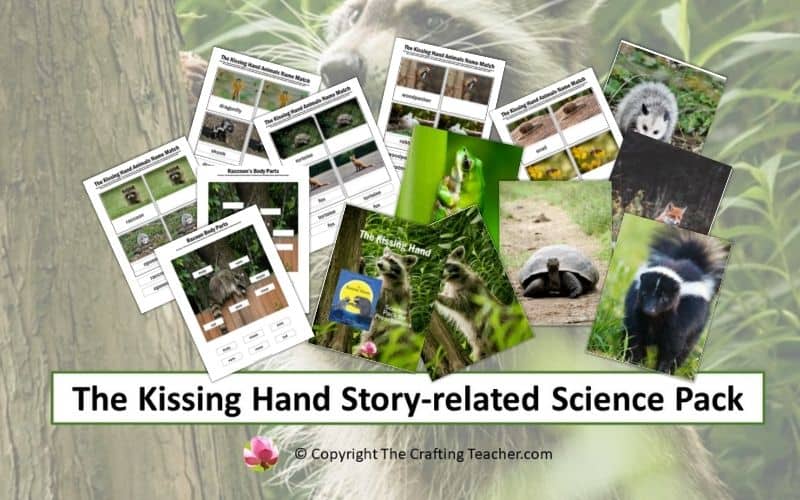
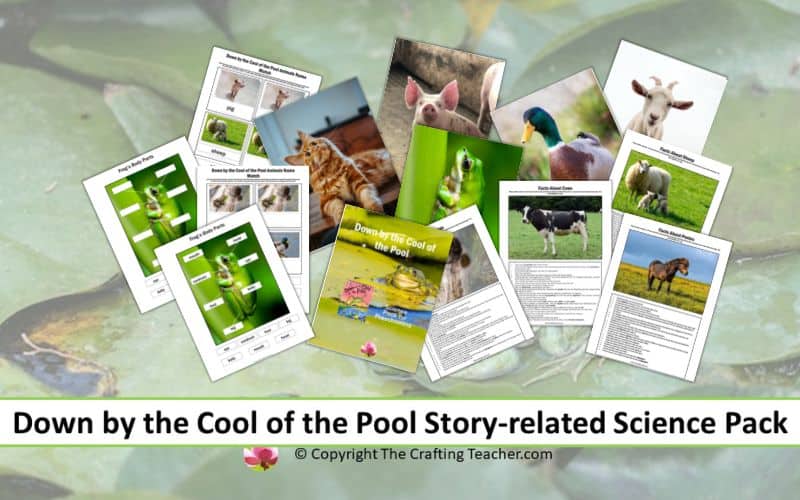
Pingback: Endangered Species Word Wall Cards - The Crafting Teacher